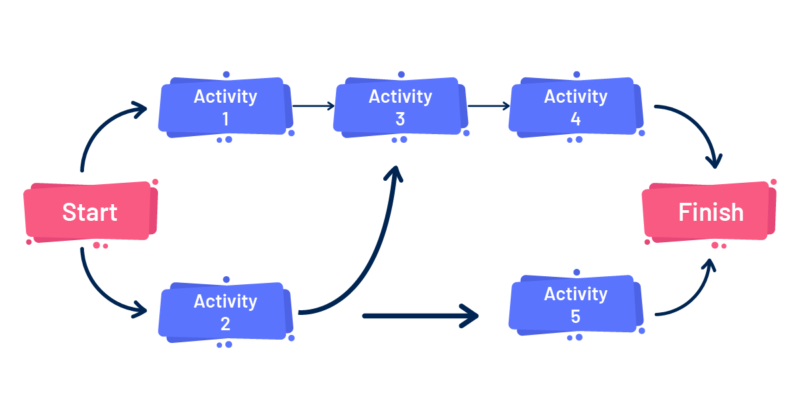
Agilemania
Agilemania, a small group of passionate Lean-Agile-DevOps consultants and trainers, is the most tru... Read more

Agilemania, a small group of passionate Lean-Agile-DevOps consultants and trainers, is the most tru... Read more

In project management, principles, tools, and techniques are used to plan, execute, and manage projects. As a result, project managers, team leaders, and other leaders can manage work while supporting team collaboration. Every management must implement PERT and CPM to accomplish the end goal of a project on time. A project's progress and series of actions can be displayed with these techniques.
PERT full form is Project Evaluation and Review Technique. In projects where the time required to complete different activities is unknown, PERT is an appropriate method. PERT is mainly used for scheduling, organizing, and integrating tasks in a project. In addition to providing the blueprint for a project, it is an effective tool for evaluating a project.
CPM full form is the Critical Path Method. CPM is used when the time needed to complete a task is already known. A project's approximate completion time is based on this tool. In project management, the critical path provides the maximum time for project completion in the shortest possible time.
In discussions about the Difference Between PERT and CPM, CPM emphasizes cost-efficiency and fixed scheduling and PERT focuses on time prediction and flexibility.
| Based On | PERT | CPM |
| Full Form | Project Evaluation and Review Technique | Critical Path Method |
| Meaning | PERT is a prominent project management approach used when the time needed to complete a project is unknown. | CPM is a statistical technique that assigns a beginning and ending time to a project. |
| Model Type | probabilistic model | deterministic model |
| Major Focus | It is primarily concerned with time since attaining a time objective or estimating a percentage of completion is more significant. | Emphasizes the time-cost trade-off since lowering costs is much more essential. |
| Nature | It has a Non-repetitive personality. | It has a repetitive nature to the job. |
| Orientation type | Event-oriented technique | Activity-oriented technique |
| Suitability | It is appropriate for research and development applications. | It is appropriate for building tasks. |
Here’s a brief explanation for each Advantage of PERT:
Planning For Large Projects
By breaking down complicated projects into smaller, more manageable tasks, PERT makes it easier to plan and monitor them.
Visibility of Critical Path
It shows teams which tasks are most important and will have the biggest impact on the project's timeline, which helps them decide what to work on first.
Analysis of Activities
PERT lets you look closely at each task, including how long it will take and what it depends on, to find possible delays.
Coordinating Ability
It helps team members work together better by making it clear what tasks need to be done in what order and how they depend on each other.
The What-if -Analysis
PERT helps with scenario planning, which lets managers look at different options and plan for things that might happen.
Here’s a brief explanation for each Disadvantage of PERT:
Time-Focused Method
PERT mainly emphasizes time estimation and doesn’t account for cost or resource management, which can limit its usefulness in broader project planning.
Subjective Analysis
The method depends a lot on expert judgment and assumptions, which can be different for each person and affect how accurate it is.
Inaccuracy due to Prediction
PERT makes predictions based on estimated time frames, so they could be wrong, especially for complicated or uncertain projects.
Expensive
Using PERT can take a lot of resources, such as skilled workers, time, and tools, which can make it expensive for smaller projects.

Establishes a framework for long-term project collaboration and planning
CPM makes it easier and more organized for teams to work together by clearly laying out tasks, deadlines, and dependencies. This helps them plan for the long term.
Recognizes critical activities
It finds tasks that have a direct effect on the project's timeline, so teams can focus on the most important things to avoid delays.
Project management is simple to plan, schedule, and control.
Project managers can effectively plan, keep track of, and change activities as needed when they have clear timelines and dependencies.
Enhance productivity
By making tasks simpler and focusing on what's most important, CPM cuts down on confusion and makes the whole team work better.
Administers the required resources
It makes sure that the right people, tools, and money are available for the right tasks at the right time.
Here’s a brief version of the Disadvantages of CPM:
It is tough to understand for newcomers.
The method can be hard to understand and may be too much for people who are new to managing projects.
Software is costly.
For small teams or organizations, the specialized software needed for CPM can be very expensive.
CPM structure might be time-consuming at times.
Building the CPM structure requires detailed planning, which can take considerable time.
It cannot regulate or shape the schedule of a project participant.
CPM doesn’t offer flexibility in managing individual team member schedules or commitments.
The distinction between PERT and CPM, these two project management tools is becoming increasingly blurred as the methodologies mix over time. As a result, in most projects, they are employed as a single project. The fundamental difference between PERT and CPM is that the former places a premium on time, implying that if time is saved, costs would be saved as well. However, with the latter, cost optimization is the most critical factor.
Project management tools like PERT (Program Evaluation and Review Technique) and CPM (Critical Path Method) are used in economics and operations research to plan, schedule, and keep an eye on complicated projects. They help make the best use of time and resources, which makes projects cheaper to do.
The main difference between PERT and CPM is what they focus on. PERT is used when the lengths of activities are uncertain (probabilistic), while CPM is used when the lengths of activities are known and set (deterministic), with an emphasis on optimizing time and cost.
The full form of CPM is the Critical Path Method in project management.
The PERT formula for estimating activity time is:
(Optimistic Time + 4 × Most Likely Time + Pessimistic Time) ÷ 6
CPM is usually more accurate for projects with clear, repetitive tasks and set deadlines. PERT is better for research or development projects where the time estimates are not clear.
Agilemania, a small group of passionate Lean-Agile-DevOps consultants and trainers, is the most trusted brand for digital transformations in South and South-East Asia.
WhatsApp Us
I recently had the privilege of attending the PSPO-Advanced class with Sumeet, and I must say, it was an outstanding lea...

Wonderful PSPO-Advanced Training by Sumeet Madan I had the chance to attend the Scrum Product Owner training by Mr. Sum...

Sumeet Madan's virtual PSPO-1 training was incredibly insightful. Sumeet possesses deep knowledge of the Scrum framework...

Insightful, practical, and engaging — the PSPO coaching sessions were incredibly valuable. Sumeet explained complex Sc...

Dear Sumeet, I just wanted to take a moment to sincerely thank you for the truly enriching PSPO training session today....

We will get back to you soon!
For a detailed enquiry, please write to us at connect@agilemania.com
We will get back to you soon!
For a detailed enquiry, please write to us at connect@agilemania.com



